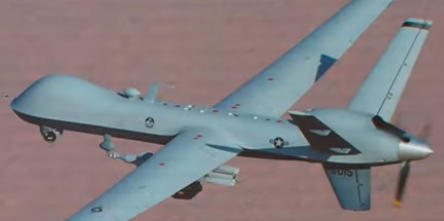by the El Reportero staff
The U.S. government is reportedly utilizing a secret drone program to track and identify fentanyl laboratories in Mexico as part of its ongoing efforts to curb the influx of illicit drugs into the United States, according to The New York Times.
Sources indicate that the Central Intelligence Agency (CIA) has been conducting covert drone flights to pinpoint fentanyl production sites, subsequently relaying the intelligence to Mexican authorities. Officials speaking to the Times on condition of anonymity revealed that this classified program initially began during the Biden administration but has expanded significantly under President Donald Trump, who has pledged to crack down on drug cartels with increased aggression.
According to a senior U.S. military official, Northern Command has carried out more than two dozen surveillance flights over the U.S.-Mexico border using a variety of aircraft, including RC-125 Rivet Joints, U-2s, P-8s, and drones. Despite the increased intelligence-gathering operations, the administration has reportedly not authorized the use of drones for lethal strikes, instead relying on them solely to support Mexican law enforcement efforts in dismantling drug operations.
CIA drones have reportedly proven effective at locating fentanyl labs, as the chemicals emitted during drug production can be easily detected from the air. The agency has declined to comment on the matter. The escalation in drone activity aligns with President Trump’s broader strategy to disrupt drug trafficking networks and pressure the Mexican government into taking a more proactive role in combating organized crime.
One of Trump’s first executive orders after returning to office was to designate drug cartels as Foreign Terrorist Organizations (FTOs), a move that grants U.S. authorities expanded legal tools to target cartel operations. This designation enables the U.S. to freeze financial assets, restrict entry into the country, and prosecute cartel affiliates under terrorism laws.
In line with these efforts, Northern Command announced in early February the formation of a specialized intelligence task force comprising 140 analysts stationed along the southern border. These analysts are tasked with processing surveillance data and assisting the U.S. Border Patrol with counter-network analysis, Spanish-language translation, and full-motion video analysis.
Facing the threat of sweeping 25 percent tariffs on Mexican exports imposed by Trump, President Claudia Sheinbaum announced on Feb. 3 the deployment of 10,000 troops to the U.S.-Mexico border. Their primary mission includes halting the flow of illicit drugs, with a particular emphasis on fentanyl, as well as addressing illegal immigration.
Sheinbaum’s decision comes amid a worsening fentanyl crisis in the U.S., where over 21,000 pounds of the drug were seized at the southern border during Biden’s final year in office, according to Customs and Border Protection data. The Drug Enforcement Administration warns that a single kilogram of fentanyl can be lethal to as many as half a million people.
Mexican authorities have also ramped up their enforcement efforts. Over the weekend, law enforcement agencies seized approximately 440 pounds of methamphetamine—worth an estimated $40 million—in a region controlled by the Sinaloa Cartel. Since the deployment of Mexico’s National Guard on Feb. 5, authorities have confiscated nearly five tons of methamphetamine, 453 kilograms of cocaine, and 55 kilograms of fentanyl.
With reports by Truth Press.



